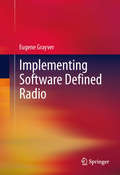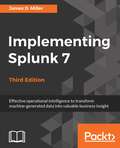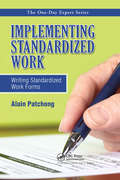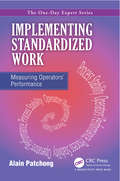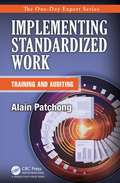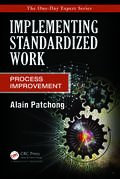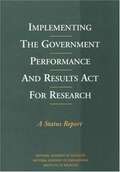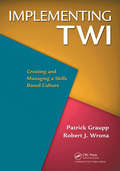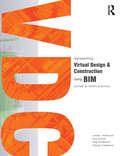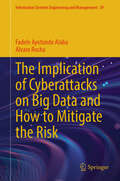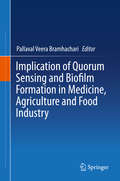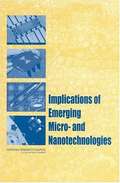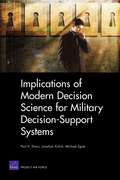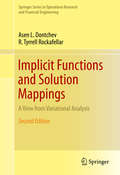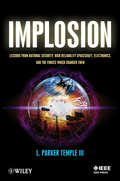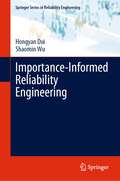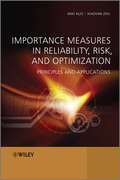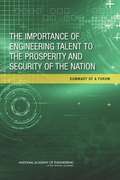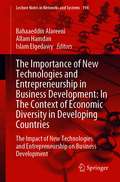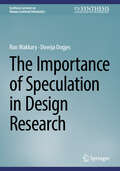- Table View
- List View
Implementing Software Defined Radio
by Eugene GrayverSoftware Defined Radio makes wireless communications easier, more efficient, and more reliable. This book bridges the gap between academic research and practical implementation. When beginning a project, practicing engineers, technical managers, and graduate students can save countless hours by considering the concepts presented in these pages. The author covers the myriad options and trade-offs available when selecting an appropriate hardware architecture. As demonstrated here, the choice between hardware- and software-centric architecture can mean the difference between meeting an aggressive schedule and bogging down in endless design iterations. Because of the author's experience overseeing dozens of failed and successful developments, he is able to present many real-life examples. Some of the key concepts covered are: Choosing the right architecture for the market - laboratory, military, or commercial, Hardware platforms - FPGAs, GPPs, specialized and hybrid devices, Standardization efforts to ensure interoperability and portabilitym State-of-the-art components for radio frequency, mixed-signal, and baseband processing. The text requires only minimal knowledge of wireless communications; whenever possible, qualitative arguments are used instead of equations. An appendix provides a quick overview of wireless communications and introduces most of the concepts the readers will need to take advantage of the material. An essential introduction to SDR, this book is sure to be an invaluable addition to any technical bookshelf.
Implementing Splunk 7, Third Edition: Effective Operational Intelligence To Transform Machine-generated Data Into Valuable Business Insight, 3rd Edition
by James D. MillerThis book will help you implement Splunk 7's new services and will show you how to utilize them to quickly and efficiently process machine-generated big data. You will explore Splunk Cloud and the Machine Learning Toolkit and use them with ease throughout your organization. By the end of the book, you will have learned to implement these services in your tasks at work.
Implementing Standardized Work: Writing Standardized Work Forms
by Alain PatchongThe first book in The One-Day Expert series detailed the initial steps that Thomas, a young, high-potential plant manager in an industrial group, took to assess his plant‘s situation through measurement of operators performance. The second book in the series, Implementing Standardized Work: Writing Standardized Work Forms focuses on the next step
Implementing Standardized Work: Measuring Operators Performance
by Alain PatchongThis book, the first in The One-Day Expert series dedicated to Standardized Work, is about operator performance measurement. Implementing Standardized Work: Measuring Operators Performance explains how to measure the performance of operators quickly and simply without sacrificing accuracy.Detailing how to identify the most efficient operators and
Implementing Standardized Work: Training and Auditing
by Alain PatchongStandardized Work refers to the process of finding and applying the best operational methods that will lead to cost reduction, better product quality, and increased operator safety. This book, the latest in a series dedicated to Standardized Work, focuses on operator training and auditing. It describes the methods and tools used to train operators
Implementing Standardized Work: Process Improvement
by Alain PatchongThis book, the third in a series dedicated to Standardized Work, focuses on process improvement. Implementing Standardized Work: Process Improvement begins by explaining why standardization and process improvement are two sides of the same coin both needing each other to achieve true sustainability.Describing how to use Standardized Work forms to i
Implementing the Government Performance and Results Act for Research: A Status Report
by Institute of MedicineAs requested by Congress and the White House Office of Science and Technology Policy (OSTP), this report assists federal agencies in crafting plans and reports that are responsive to the Government Performance and Results Act (GPRA), OMB Guidance, and agency missions. Using a case study approach, the report identifies best practices used by individual agencies to evaluate the performance and results of their science and technology programs. The report takes into account individual agencies' missions and how science and technology programs and human resource needs are factored into agency GPRA plans. Specific applications of recommendations are included from COSEPUP's earlier report entitled Evaluating Federal Research Programs: Research and the Government Performance and Results Act.
Implementing TWI: Creating and Managing a Skills-Based Culture
by Patrick Graupp Robert J. WronaFeaturing strategies employed in Lean, this volume describes the experiences of organizations using TWI more than 60 years after the Training Within Industry program turned the U.S. into the industrial giant that won World War II. Based on their experience implementing TWI in organizations as diverse as Virginia Mason Medical Center and Donnelly Ma
Implementing Virtual Design and Construction using BIM: Current and future practices
by Lennart Andersson Kyla Farrell Oleg Moshkovich Cheryle CranbourneImplementing Virtual Design and Construction using BIM outlines the team structure, software and production ecosystem needed for an effective Virtual Design and Construction (VDC) process through current real world case studies of projects both in development and under construction. It provides the reader with a better understanding of the successful implementation of VDC and Building Information Modeling (BIM), and the benefits to the project team throughout the design and construction process. For readers already familiar with VDC, the book will provide invaluable examples of best practices and real world solutions. Richly illustrated in color with actual VDC documentation, visualizations, and statistics, the reader is shown the real processes undertaken and outputs generated when working on high profile building information models. Online animations, interviews with practitioners, and downloadable templates, forms and files make this an interactive and highly engaging way to learn a crucial set of skills. While keeping up with current industry practice is a minimum requirement, this book goes further by helping you prepare for the next level of virtual design and construction. This is essential reading for project managers, construction managers, architects, design managers, and anybody with a role in BIM or virtual construction.
The Implication of Cyberattacks on Big Data and How to Mitigate the Risk (Information Systems Engineering and Management #39)
by Fadele Ayotunde Alaba Alvaro RochaThis comprehensive book explores the challenges posed by cyberattacks on big data systems and their corresponding mitigation strategies. The book is organized into logical chapters, each focusing on specific aspects of the subject, ensuring clarity and depth in addressing the multifaceted nature of the problem. The introductory chapter provides a clear overview of the problem, introducing the prevalence of cyberattacks on big data systems, the motivation for addressing these risks, and the goals of the book. It also outlines the goals of the book, such as identifying vulnerabilities, evaluating mitigation strategies, and proposing integrated solutions. The second chapter provides a detailed examination of cyberattacks, emphasizing their implications for big data systems. It systematically categorizes tools and techniques available for mitigating these risks, including identity and access management (IAM), symmetric data encryption, network firewalls, IDPS, data loss prevention (DLP), SIEM, DDoS protection, and big data backup and recovery strategies. The book focuses on key mitigation techniques, such as IAM, encryption methods, network segmentation, firewalls, and intrusion detection systems. It also proposes an integrated cybersecurity model, combining these solutions for enhanced effectiveness against cyberattacks. The book also identifies research gaps and suggests areas for future research, such as adapting to emerging technologies and improving scalability in big data security frameworks. The book is a valuable resource for cybersecurity professionals, researchers, and practitioners aiming to address the unique challenges posed by cyberattacks on big data systems. The book aims to equip various professionals with the knowledge and strategies necessary to address the vulnerabilities associated with cyberattacks on big data environments.
Implication of Quorum Sensing and Biofilm Formation in Medicine, Agriculture and Food Industry
by Pallaval Veera BramhachariThe book illustrates the role of quorum sensing in the food industry, agriculture, veterinary sciences, and medicine. It highlights the importance of quorum sensing in regulating diverse cellular functions in microbes, including virulence, pathogenesis, controlled-gene expression systems, and antibiotic resistance. This book also describes the role of quorum sensing in survival behavior and antibiotic resistance in bacteria. Further, it reviews the major role played by quorum sensing in food spoilage, biofilm formation, and food-related pathogenesis. It also explores the methods for the detection and quantification of quorum sensing signals. It also presents antimicrobial and anti-quorum sensing activities of medicinal plants. Finally, the book elucidates a comprehensive yet representative description of basic and applied aspects of quorum sensing inhibitors. This book serves an ideal guide for researchers to understand the implications of quorum sensing in the food industry, medicine, and agriculture.
Implications of Emerging Micro- and Nanotechnologies
by Committee on Implications of Emerging Micro- NanotechnologiesExpansion of micro-technology applications and rapid advances in nano-science have generated considerable interest by the Air Force in how these developments will affect the nature of warfare and how it could exploit these trends. The report notes four principal themes emerging from the current technological trends: increased information capability, miniaturization, new materials, and increased functionality. Recommendations about Air Force roles in micro- and nanotechnology research are presented including those areas in which the Air Force should take the lead. The report also provides a number of technical and policy findings and recommendations that are critical for effective development of the Air Force's micro- and nano-science and technology program.
Implications of Modern Decision Science for Military Decision-Support Systems
by Jonathan Kulick Michael Egner Paul K. DavisA selective review of modern decision science and implications for decision-support systems. The study suggests ways to synthesize lessons from research on heuristics and biases with those from "naturalistic research." It also discusses modern tools, such as increasingly realistic simulations, multiresolution modeling, and exploratory analysis, which can assist decisionmakers in choosing strategies that are flexible, adaptive, and robust.
Implications Of Nanotechnology For Environmental Health Research
by Institute of Medicine of the National AcademiesThe National Academies Press (NAP)--publisher for the National Academies--publishes more than 200 books a year offering the most authoritative views, definitive information, and groundbreaking recommendations on a wide range of topics in science, engineering, and health. Our books are unique in that they are authored by the nation's leading experts in every scientific field.
Implications of Pyrite Oxidation for Engineering Works
by A. Brian HawkinsThe book highlights and analyses the distress to buildings caused by sulphate-induced heave, with particular reference to the recent problems in the Dublin area of Ireland. It describes the formation of pyrite, the processes involved in its oxidation and the various ways in which consequential expansion takes place. For the first time in the literature it discusses the way that buildings can be raised above their supporting foundation walls by the expansion of pyritiferous fill which has been used beneath ground-bearing floor slabs in Ireland. The significance of fractures through the iron sulphide microcrystals for the rate and extent of oxidation is discussed. Photographs and profiles of sulphate ingress into concrete/concrete blocks are presented. Case histories from the UK, North America and Ireland are discussed.
Implicit Functions and Solution Mappings
by R. Tyrrell Rockafellar Assen L. DontchevThe implicit function theorem is one of the most important theorems in analysis and its many variants are basic tools in partial differential equations and numerical analysis. This book treats the implicit function paradigm in the classical framework and beyond, focusing largely on properties of solution mappings of variational problems. The purpose of this self-contained work is to provide a reference on the topic and to provide a unified collection of a number of results which are currently scattered throughout the literature. The first chapter of the book treats the classical implicit function theorem in a way that will be useful for students and teachers of undergraduate calculus. The remaining part becomes gradually more advanced, and considers implicit mappings defined by relations other than equations, e.g., variational problems. Applications to numerical analysis and optimization are also provided. This valuable book is a major achievement and is sure to become a standard reference on the topic.
Implosion: Lessons from National Security, High Reliability Spacecraft, Electronics, and the Forces Which Changed Them
by L. Parker TempleImplosion is a focused study of the history and uses of high-reliability, solid-state electronics, military standards, and space systems that support our national security and defense. This book is unique in combining the interdependent evolution of and interrelationships among military standards, solid-state electronics, and very high-reliability space systems. Starting with a brief description of the physics that enabled the development of the first transistor, Implosion covers the need for standardizing military electronics, which began during World War II and continues today. The book shows how these twin topics affected, and largely enabled, the highest reliability and most technologically capable robotic systems ever conceived. This riveting history helps readers: Realize the complex interdependence of solid-state electronics and practical implementations in the national security and defense space programs Understand the evolution of military standards for piece parts, quality, and reliability as they affected these programs Gain insight into the attempted reforms of federal systems acquisition of security- and defense-related space systems in the latter half of the twentieth century Appreciate the complexity of science and technology public policy decisions in the context of political, organizational, and economic realities Written in clear, jargon-free language, but with plenty of technical detail, Implosion is a must-read for aerospace and aviation engineers, manufacturers, and enthusiasts; technology students and historians; and anyone interested in the history of technology, military technology, and the space program.
Importance-Informed Reliability Engineering (Springer Series in Reliability Engineering)
by Hongyan Dui Shaomin WuThis book provides university students and practitioners with a collection of importance measures to design systems with high reliability, maintain them with high availability, and restore them in case of failures. Optimal reliability design, properly system maintenance and resilience management are vital for retaining a high level of system availability. Reliability importance measures, which are used to identify the weakest components from different perspectives, can be used to achieve this goal. The book has seven parts. Chapter 1 introduces the basic concepts. Chapter 2 focuses on importance measures for the system design phase and introduces how the system reliability can be improved with importance measures. Chapters 3 and 4 provide importance measures-related methods for scheduling maintenance policies under different scenarios. Chapter 5 provides importance measures for networks. Chapter 6 proposes importance measures for resilience management. The last chapter, or Chapter 7, illustrates the importance measures with case studies adopted from four types of systems: mechanical systems, energy systems, transport networks, and supply chain networks.
Importance Measures in Reliability, Risk, and Optimization
by Xiaoyan Zhu Way KuoThis unique treatment systematically interprets a spectrum of importance measures to provide a comprehensive overview of their applications in the areas of reliability, network, risk, mathematical programming, and optimization. Investigating the precise relationships among various importance measures, it describes how they are modelled and combined with other design tools to allow users to solve readily many real-world, large-scale decision-making problems. Presenting the state-of-the-art in network analysis, multistate systems, and application in modern systems, this book offers a clear and complete introduction to the topic. Through describing the reliability importance and the fundamentals, it covers advanced topics such as signature of coherent systems, multi-linear functions, and new interpretation of the mathematical programming problems.Key highlights:Generalizes the concepts behind importance measures (such as sensitivity and perturbation analysis, uncertainty analysis, mathematical programming, network designs), enabling readers to address large-scale problems within various fields effectivelyCovers a large range of importance measures, including those in binary coherent systems, binary monotone systems, multistate systems, continuum systems, repairable systems, as well as importance measures of pairs and groups of componentsDemonstrates numerical and practical applications of importance measures and the related methodologies, including risk analysis in nuclear power plants, cloud computing, software reliability and moreProvides thorough comparisons, examples and case studies on relations of different importance measures, with conclusive results based on the authors' own researchDescribes reliability design such as redundancy allocation, system upgrading and component assignment.This book will benefit researchers and practitioners interested in systems design, reliability, risk and optimization, statistics, maintenance, prognostics and operations. Readers can develop feasible approaches to solving various open-ended problems in their research and practical work. Software developers, IT analysts and reliability and safety engineers in nuclear, telecommunications, offshore and civil industries will also find the book useful.
The Importance of Engineering Talent to the Prosperity and Security of the Nation
by Steve OlsonThe quality of engineering in the United States will only be as good as the quality of the engineers doing it. The recruitment and retention of talented young people into engineering therefore need to be top national priorities, given the crucial importance of engineering to our prosperity, security, health, and well-being. Only 4. 4 percent of the undergraduate degrees awarded by US colleges and universities are in engineering, compared with 13 percent in key European countries (the United Kingdom, Sweden, Finland, Denmark, Germany, and France) and 23 percent in key Asian countries (India, Japan, China, Taiwan, South Korea, and Singapore). In the past, the United States has been able to attract engineering graduate students and professionals from other countries to meet the need for engineering talent in the public and private sectors. But other countries are providing increasingly attractive opportunities for engineers, with excellent salaries, facilities, and economic growth potential. The United States can no longer assume that the best engineering talent in the world will want to come to this country. "The Importance of Engineering Talent to the Prosperity and Security of the Nation" is the summary of a forum held during the National Academy of Engineering's 2013 Annual Meeting. Speakers discussed the opportunities and challenges of creation and wise use of engineering talent, and made recommendations for recruitment and retention strategies. This report assesses the status of engineering education in the U. S. and makes recommendations to promote and improve engineering education.
The Importance of Greenery in Sustainable Buildings (Innovative Renewable Energy)
by Ali Sayigh Antonella TrombadoreThis book covers the important aspects of greenery in buildings, both in the landscape and within buildings, examining how greenery improves comfort and appeal in sustainable buildings. The book is part of the World Renewable Energy Network’s drive to encourage architects and builders to use greenery as much as possible in their design to reduce energy consumption and provide a pleasant appearance and pleasing aspect to their buildings. It shows and demonstrates how widespread the use of greenery is in buildings, and the books 17 chapters were chosen from 12 different countries representing a truly global look at the use and benefit of using greenery in buildings. This book is aimed at architects, building construction authorities, urban planners, and policymakers to encourage the use of greenery in their future buildings and explain why it is important to do so.
The Importance of New Technologies and Entrepreneurship in Business Development: The Impact of New Technologies and Entrepreneurship on Business Development (Lecture Notes in Networks and Systems #194)
by Bahaaeddin Alareeni Allam Hamdan Islam ElgedawyThis book introduces the students, researchers and practitioners into the subject and enabling technologies and applications pertaining to of technology, entrepreneurship and business development through research articles, case studies etc. It is primarily intended for academic purposes for learners of computer Science, management, accounting and information systems disciplines, economics,- entrepreneurship. Publishing chapters in the book is new innovative idea to spread the book in the Middle East and Arab countries and make the book achieve more sales. As many students in all levels, graduates and undergraduates in addition to research, professionals are not able to get sufficient resources because of the language concern.
The Importance of Packaging Design for the Chemistry of Food Products
by Giovanni Brunazzi Salvatore Parisi Amina PerenoThis Brief defines reliable correlations between the food packaging design and its chemical features in terms of an 'integrated food product' (the synergistic union composed of the edible content and its container). A good design, as described in this Brief, implies the best choices from a series of possibilities, taking into account economical and commercial influences or limitations in the production and processing chain and the chemical interactions that can arise between the food containers and the contained edible material. This Brief highlights how the different requirements can be combined, while avoiding dangerous food risks originating from the chemical interaction between the container and the product. Different designs are critically analysed with relation to the effect on contained foods. The influences and resulting consequences of different possible food packaging designs are highlighted and discussed in selected case studies for some every-day products (like potato chips).
The Importance of Speculation in Design Research (Synthesis Lectures on Human-Centered Informatics)
by Ron Wakkary Doenja OogjesThis book explores speculation in design research in the field of human-computer interaction (HCI). The authors reveal how speculative reasoning in design research increases the capacity of HCI to address a wider array of social and research challenges. Speculation in design research employs (1) leaps of imagination, (2) diverse ways of knowing or epistemologies, (3) ethical reflexivity, (4) and makes alternate possibilities experiential. This book shows how each can be productively and critically applied together through existing, emerging, and new research approaches in HCI. The aim of this book is to generously see speculation as more than a form of critique or genre of design research, to instead be seen as broadly central to the material investigations that govern much of the field. In doing so, the book aims to expand the potential role of speculation in HCI and shows how speculation is applicable to a wide range of research goals, which, in turn, creates research approaches in new directions. In expanding the approach and methodology of speculation in HCI, the books draw inspiration from other disciplines and intersectional perspectives. By examining current, emerging, and possible new forms of speculation methods, this book will be of interest to undergraduate and graduate students in HCI as well as seasoned researchers and practitioners.
The Importance of Wood and Timber in Sustainable Buildings (Innovative Renewable Energy)
by Ali SayighThis book emphasizes the important message that architects and structural engineers must strive to ensure that the buildings they design and construct should not be major contributors to climate change. Rather, they should be exploring the use of green materials and building methods – such as timber, wood, and associated materials – in order to safeguard the environment. These sustainable materials are not only environmentally friendly, but they have the added benefit of being easy to manufacture, cost effective, often locally available, and easily replenished. Moreover, it has been demonstrated that wood and timber are viable materials in the construction of a wide variety of building types, including medium and high-rise buildings.The Importance of Wood and Timber in Sustainable Buildings brings together a distinguished group of contributors from different cultures and building traditions to address why now is the time to rethink our construction methods and explore replacing many of the carbon intensive materials that are currently being used with wood and timber.
